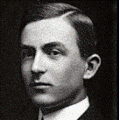
Raymond Hood (1881 – 1934)
American architect Raymond Hood straddled the centuries. He became famous for Neo-Gothic and Art Deco buildings. By the end of his career, however, Raymond Hood was designing buildings so modern that they foretold the International Style.
Raymond Hood became famous in 1922 when he and John Howells won a competition to design the Chicago Tribune Tower. The design by Raymond Hood and John Howells was selected over some 200 entries, including designs by great names like Walter Gopius, Adolf Loos, and Eliel Saarinen.
Raymond Hood is perhaps best known for his work on Rockefeller Center in Midtown Manhattan in New York City. Covering 22 acres, Rockefeller Center encompasses 19 buildings, including the Art Deco Radio City Music Hall. Critics have described Rockefeller center a symbol of modernist capitalist architecture.
When Raymond Hood designed New York’s McGraw-Hill Building, he was thoroughly grounded in modernism. Clad with blue-green terra cotta, the McGraw-Hill Building has been called both Art Deco and Streamline Moderne. But the horizontal bands of windows and lack of ornamentation suggest the emerging International Style.
Outstanding work:
1924: Tribune Tower, Chicago, IL
1924: American Standard Building, New York, NY
1929: Daily News Building, New York, NY
1930: Masonic Temple (Scranton Cultural Center), Scranton, Pennsylvania
1933: GE Building, New York, NY
1933-1937: Rockefeller Center and Radio City Music Hall, New York, NY
1934: McGraw-Hill Building, New York, NY